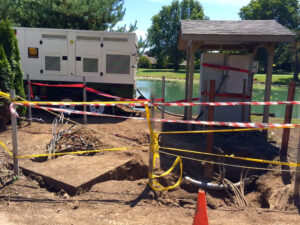 If you do have a Skunk Problem, here is information that may help
If you do have a Skunk Problem, here is information that may help
Signs of skunk damage may include:
- Holes in lawn: small and cone-shaped; 3 to 4 inches in diameter.
- Skunk tracks: five toes on each foot with visible claws.
- Pilfered trash cans
Skunk Removal and prevention
(Source Purdue University and Wildlife Damage blog)
When skunks are living or rearing young under buildings, attempts to destroy them may result in the release of their noxious scent.
- Seal all possible entrances along the foundation, but leave the main burrow open.
- Before attempting removal, sprinkle a liberal amount of flour or a similar substance in and around the entrance.
- After dark, check for tracks to determine which openings they used as exits and the number of skunks involved.
- When the animals have left, close all possible entrances with sheet metal or hardware cloth to avoid reentry.
- Reopen the entrance the next day for 1 hour after dark to allow any remaining skunks to exit before permanently sealing the entrance.
- Remove unused pet food and water bowls at night and keep lids on trash cans to aid in discouraging skunks. Since skunks prey on the rodents that are attracted to scattered bird seed, take bird feeders in at night or attach a catch-screen to the bottom of the feeder.
- Fencing usually keeps skunks out of the yard; however, they will sometimes dig under. To prevent burrowing beneath a fence or other structure (sheds, decks, etc.), attach a 3-foot wide heavy gauge wire mesh screen to the bottom of the fence so it extends >24 inches outward. Secure the screen to the ground with garden staples and backfill over the mesh with rock mulch.
What if you meet the Skunk?
Deodorizing You, Your Pets and Your Clothes (From MrsClean blog)
This solution loses effectiveness almost immediately, so it cannot be stored and you will need to make a fresh batch whenever the skunks attack.
Store a sealed bottle of hydrogen peroxide and a small container of baking soda (separately) up in your cupboard so you’ll be ready in case of an emergency.
- 1 quart of 3% hydrogen peroxide (from drug store)
- 1/4 cup of baking soda (sodium bicarbonate)
- 1 teaspoon of liquid detergent
Mix together the hydrogen peroxide, baking soda and a few drops of dishwashing liquid. This is extremely effective at removing skunk smell and is actually recommended by chemists and proven to be highly effective. The hydrogen peroxide and baking soda work together to neutralize the odor, while the degreasing action of the dishwashing liquid help to remove the oily substance that contains the odor causing chemicals.
- Remove clothes immediately and wash them in the hottest water possible. Use the strongest laundry soap you have. It may take a while, but the smell will go away.
- If you are the victim, hop in the shower and cover yourself liberally with the homemade skunk odor recipe above.
- Wash pets right away using the same recipe. It’s safe for everyone.
- Rinse completely.
Deodorizing Outdoor Items
Skunks don’t just spray people and pets, they spray your outdoor items, too. Skunks like to mark their territory, just like many other animals do. Favorites can include tires, corners of a home, a tree…it doesn’t really matter where it is because if you can smell it, it is definitely an issue.
Bleach was the best method for deodorizing outdoor items that had been sprayed
- One part bleach
- Nine parts water
Make sure to rinse the area thoroughly with water after scrubbing because bleach is caustic and will damage or disintegrate that it is left on over time. (Do not use bleach on paint)
*MrsClean (http://www.housecleaningcentral.com/en/cleaning-services/mrs-clean/about-us.html) is a housecleaning professional in Redland Washington.
Facts about Skunks if you are interested:
Skunks are a member of the weasel family. They vary in size (most are house cat-sized) and appear in a variety of striped, spotted, and swirled patterns—but all are a vivid black-and-white that makes them easily identifiable and may alert predators to their pungent potential.
Average Size: 20 – 30″ long (including the tail); 6 – 10 lbs.
Average Lifespan in the Wild: 2 4 years
Skunks usually nest in burrows constructed by other animals, but they also live in hollow logs or even abandoned buildings. Skunks are extremely adaptable and thrive in many different habitats, as long as food and shelter are available. Because they rarely travel more than 2 miles from their established dens, a skunk will typically settle down within 2 miles of a water source.
Mother skunks give birth to litters of two to ten young each year, usually in May, but can birth as late as early June. The babies follow their mothers around for several months, leaving in late July or early August.
Spray: A skunk’s spray is an oily liquid produced by glands under its large tail. To employ this scent bomb, a skunk turns around and blasts its foe with a foul mist that can travel as far as ten feet (three meters). The odor can be detected up to 1.5 miles.
When a skunk is being chased by a predator first they will exhibit threat behaviors, stomping their front fee and hissing. Next they will spray an atomized cloud, that the predator will run through. Finally they will spray a stream directed at the predator’s face.
Digging: Skunks have strong forefeet and long nails which make them excellent diggers. They dig holes in lawns, gardens and golf courses in search of food like grubs and earthworms. When no other form of shelter is available, they may even burrow under buildings by entering foundation openings.
What they eat: Skunks are opportunistic eaters with a varied diet. They are nocturnal foragers who eat fruit and plants, insects, larvae, worms, eggs, reptiles, small mammals, and even fish. Skunks primarily eat insects, especially harmful to agriculture.
Disease Transmission (source Purdue University): Skunks are a primary source of rabies in many areas of the United States. Human and domestic pet contact with skunks should be avoided. If it is necessary to handle a skunk, take all precautions to keep from being bitten or scratched. Several other types of diseases and parasites affect skunks such as distemper, mange, fleas, ticks, lice, roundworms and tapeworms.


